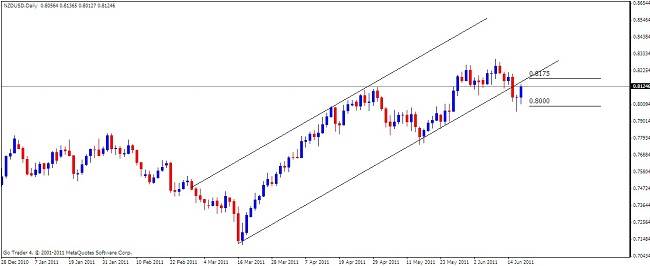U.S. Dollar. Our bias NEUTRAL, on the sidelines till a clearer picture develops.
FUNDAMENTALS: The U.S. Dollar Index closed out the week at 74.98 as global equity markets were highly volatile thanks to a round of soft June U.S. manufacturing data and fears that European policy makers had lost control of the Greek sovereign debt crisis. The S&P500 avoided a seventh straight down week, finishing higher by less than 0.10%, the NASDAQ continued to languish, losing 1.0% while the DJIA eked out a small gain finishing up 0.40%. The deteriorating situation for Greece is perhaps the most pressing concern for the markets as the global implications of this situation are particularly vast. Last week, the effort to keep a member of the EU (the world’s largest collective economy) from falling into default was made more difficult when Greece’s Prime Minister, George Papandreou was forced to shuffle his cabinet and call a vote of confidence. Considering the Troika (EU, ECB & IMF) was already facing considerable troubles to meet a resolution on the nation’s second bailout, the addition of a more demanding Greece in the negotiations will only make matters worse. A short-term fix will be put in place as Germany seems resigned to abandon demands for a rollover in bonds to a seven year maturity - but that is only for the next tranche of aid from the first package. Depending on how the Greek band aid is perceived by the market, it can temporarily curb the pressure on capital markets and cool support for the U.S. Dollar. On the other hand, should the market turn skeptical on the outcome of this effort or find a road block on progress; then there will be support for the Greenback as fear of financial crisis for the Euro-area will encourage foreign investors to pull their capital and put it in an alternative market with equivalent liquidity - the U.S. Dollar. Fallout from a Greek default would have immediate implications for many fellow EU members that have exposure to the nation’s public and private debt but importantly, the sudden rush of capital to safe haven assets will cause a ripple effect to global equities, speculative commodities, debt markets and the U.S. Dollar as a currency of last resort. The Greenback’s safe haven appeal is unique in that it stands out when there is a need for liquidity (the ability to access your money). Looking at the week ahead, Tuesday sees existing home sales followed by Wednesdays FOMC rate decision with Thursdays new home sales and Fridays core durable goods report rounding out the week. With QE2 scheduled to end this month, the Federal Reserve is unlikely to withdraw all of its capital immediately but expectations are for markets to start pricing in the eventuality.
TECHNICALS: Support at 73.50, resistance 76.00. Price remains below the trendline that extends off of the June 2010 and January 2011 highs, which keeps the U.S. Dollar under pressure but the rally from the May low is sharp and the largest since the top in December 2010. This price action suggests that a major low is forming. Failure to stay above 73.50 support would cause concern with this level being the line in the sand for Dollar bulls. We maintain a neutral outlook for the Greenback in the week ahead until a clearer picture develops with risk sentiment.
Euro Dollar. Our bias BEARISH, we”ll be looking to sell on rallies
FUNDAMENTALS: The Euro closed the week down 0.36% against the U.S. Dollar at the 1.4300 handle after news that policy officials had devised an aid package for debt stricken Greece that would include voluntary private sector participation. However, the situation in Greece continues to weigh heavily on market sentiment as contagion fears gather pace. Yesterday, the EU convenes for a meeting on the Greek bailout with European Finance Ministers meeting in Luxembourg today, and as policy officials struggle to reach a consensus on the terms of additional aid, markets will remain poised to react on further developments. While ECB President Trichet cited the much anticipated “strong vigilance” language to signal a further rate hike at the June 9th ECB policy meeting, the Euro has been unable to shake the downward pressure fueled by scenes of Greek anti-austerity protestors taking to the streets. The Euro’s rally on Friday was also reigned in by reports that Moody’s was placing Italy’s aA2 rating on review for a possible downgrade. The rating agency stated that “economic growth challenges due to macroeconomic structural weaknesses and a likely rise in interest rates over time may impede the nation’s ability to implement fiscal consolidation plans that are required to reduce Italy’s stock of debt and keep it at affordable levels”. The news is likely to keep pressure on the Euro as contagion fears are rekindled with expectations of further declines in the week ahead. On the economic data front this week, we have Mondays German producer price index, the ZEW economic survey on Tuesday followed by a slew of preliminary PMI reports on Thursday. Finally, the German Ifo Business reading rounds out the week on Friday.
TECHNICALS: Support at 1.4150, resistance 1.4500. Price remains above the trendline that extends off of the January and May lows so the potential for strength into the 1.4400 - 1.4500 area early next week remains. If a larger top is in place, then 1.4500 should hold as key resistance. The line in the sand for Euro bears is the June high at 1.4695, with a daily close above this level negating the bearish outlook. We remain bearish Euro in the week ahead and are looking to sell on rallies.
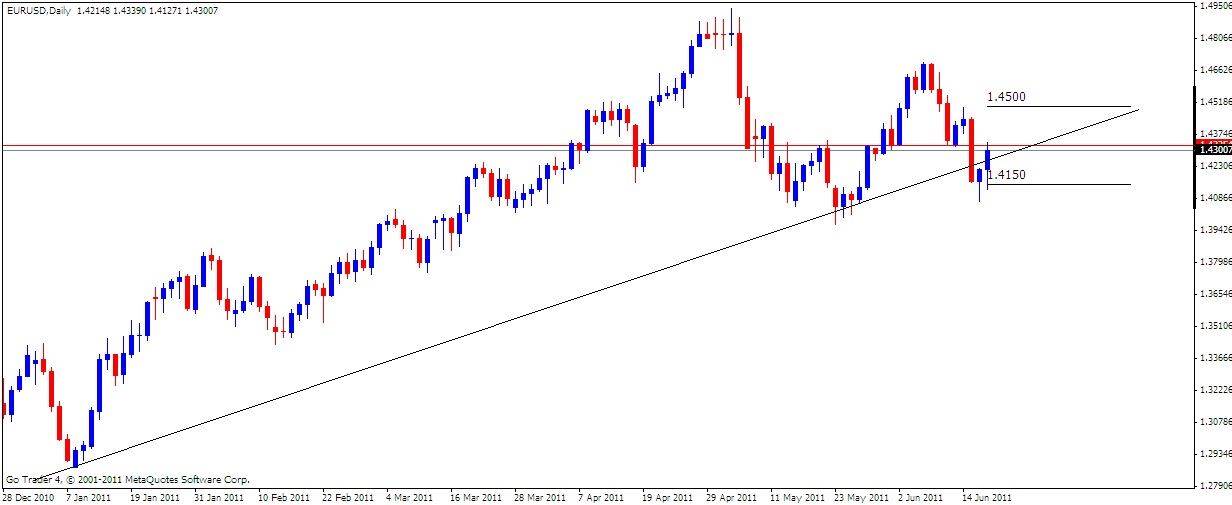
Japanese Yen. Our bias NEUTRAL, on the sidelines till a clearer picture develops.
FUNDAMENTALS: The Japanese Yen finished last week virtually unchanged against the U.S. Dollar at 80.01. With the Yens sensitivity to risk sentiment, the correlation with US Treasury bond yields and a barren economic calendar, these weeks” wider fundamental developments may see volatile price movement for the Asian currency. The pressure begins over the weekend as Greek Prime Minister George Papandreou stands for a confidence vote and carries into today as EU finance ministers gather for a summit in Luxembourg in an attempt to lay the foundation for a fruitful meeting of the region’s heads of state this Friday. In the interim, the U.S. Federal Reserve is set to deliver its monetary policy announcement on Wednesday, the first since signaling an end to QE2. Looking first at the situation in the Euro Zone, Fridays coming together of policy officials at the last possible moment to avert disaster and cobble together a compromise is a familiar way to get things done in the EU. While it doesn’t solve any of Greece’s core problems, a relatively credible setup that pushes resolving the issue far enough down the road may be met with optimism in the financial markets, with a potential upswing in risk appetite likely to weigh on the Japanese Yen as traders re-enter carry trades funded cheaply in the perennially low-yielding currency. As for the Fed, significant policy changes are essentially off the agenda after the end of QE2 was cemented last month, with markets turning their attention to the tone of the rhetoric accompanying the announcement as they attempt to reconcile increasingly hawkish posturing from a number of Fed officials (including Plosser, Fisher and Kocherlakota) with the neutral to dovish approach taken by Ben Bernanke himself. This weeks spotlight will be on the press conference that the Fed Chairman will hold after the rate decision and the phrase to keep rates low for an “extended period” in the commentary. With all of this yet to play out, Yen price action in the week ahead looks likely to be determined by broader market risk sentiment.
TECHNICALS: Support at 79.55, resistance 81.00. The latest USDJPY attempt rally higher appears to have failed at the 20 SMA (false break above trendline). A drop below 79.55 would shift focus to the panic lows at 77.20. Price trading above 81.50 would strongly suggest that the larger advance is underway towards 82.20. We maintain a neutral outlook for the Yen going forward this week ahead until a clearer picture develops with risk sentiment.
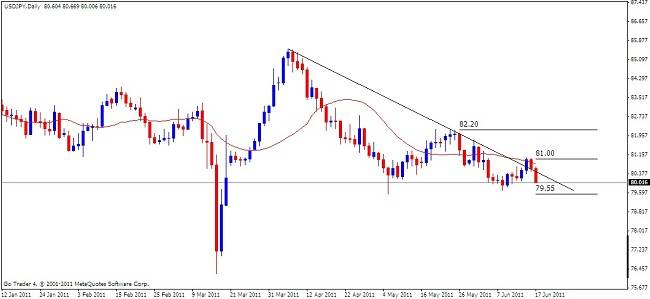
British Pound. Our bias BEARISH, we”ll be looking to sell on rallies.
FUNDAMENTALS: Sterling declined 0.20% against the U.S. Dollar by Fridays close to 1.6189, as much of the market sentiment surrounding the Pound continues to be negative. Data out of the U.K. last week was exceptionally bleak, with Aprils” industrial production and manufacturing data falling short of expectations, and consumer prices and producer prices showing that inflation remains a significant concern for the economy. Although the producer price figure fell short of the survey figure, a 4.5% year over year rate for the consumer price index, coupled with weak components of growth, further suggest that the British economic recovery is struggling at best. While significant U.K. data is much lighter this week, it is unlikely that Sterling will find much relief in a market already on edge, shifting towards further risk aversion as the debt situation in nearby Greece continues. The British housing market, one of the major sectors continuing to weigh on the recovery in the U.K. has data due out Sunday, with the Rightmove House Price report due. The index has not expanded by more than 0.9% since November 2010, and is unlikely to reach the same level of growth again as housing prices expanded by a soft 0.7% in May. Public finances data is due at the start of the European session on Tuesday. However, the most important event for Sterling this week is the release of the Bank of England minutes from their most recent meeting last Thursday. The BoE kept their rates on hold, as expected, at 0.50%, despite the continued build up of price pressures in the British economy. With ultra-hawk Andrew Sentence off of the Monetary Policy Committee, it will be interesting to see how the dynamic has shifted in favor of the doves, and how this will affect future rate decisions amid an economy moving further toward a stagflationary state.
TECHNICALS: Support at 1.6110, resistance 1.6275. GBPUSD has broken below the trendline that supported price action since the 2010 lows and this drop warrants a short on rallies approach. Initial resistance is former support at 1.6275. Looking forward, a break below 1.6055 would shift focus to 1.5850, suggesting an eventual drop below 1.5000 in the months to come. We remain bearish Sterling in the week ahead and are looking to sell on rallies.
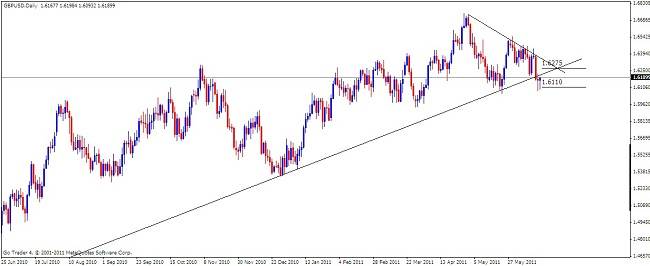
Canadian Dollar. Our bias BEARISH, we”ll be looking to sell on rallies.
FUNDAMENTALS: The Canadian Dollar closed virtually unchanged against the U.S. Dollar last week as risk on/off sentiment kept USDCAD range bound. Despite a surprise drop in the unemployment rate to 7.4% from 7.6%, the Loonie is expected to see further declines as concerns over growth in the U.S. and sovereign debt fears in Europe continue to weigh on risk appetite. With the FOMC rate decision on tap next week, markets will be looking to the Fed for clues as to the central banks rate outlook, as the Bank of Canada is unlikely to move on rates ahead of the Fed. As ongoing softness in the U.S. economy becomes more evident, the Fed is widely expected to keep interest rates at record lows for the remainder of the year and Chairman Bernanke will likely keep the “extended period” language in an effort to ensure the recovery remains on proper footing. Interest rate expectations from the BoC continue to diminish with Credit Suisse Overnight Swaps now factoring in only 53 basis points of hikes for the next twelve months. Expectations have fallen considerably from May peak of 95 basis points as weaker growth prospects and disappointing economic data from the US continued to weigh on Loonie rate expectations. In the week ahead, markets will be eyeing the retail sales figures out of Canada on Tuesday with consensus estimates calling for a print of 0.5% m/m, up from a previous flat read in May. A weaker than expected print would likely see further losses for the Loonie as traders look likely to pare back risk exposure.
TECHNICALS: Support at 0.9670, resistance 0.9900. USDCAD is at trend-line resistance that dates back to August 2010. A daily close above this level targets 0.9900 and further up 1.0000, with only a daily close below 1.9670 negating the bearish scenario. We remain bearish Loonie in the week ahead and are looking to sell on rallies.
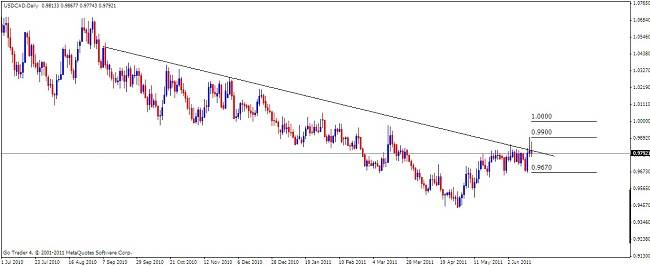
Australian Dollar. Our bias NEUTRAL, on the sidelines till a clearer picture develops.
FUNDAMENTALS: The Australian Dollar was similar to its fellow commodity currency the Loonie, closing virtually unchanged against the U.S. Dollar last week as markets remained indecisive towards risk sentiment. The week ahead may see the Aussie under pressure ahead of the Reserve Bank of Australia’s policy meeting minutes due on Tuesday if the RBA indicates a balanced position for future monetary policy. Last week, RBA Governor Glenn Stevens warned that the marked appreciation in the AUDUSD is having significant effects on the economy, but went onto say that inflation is “more likely to rise than fall over the next couple of years” as the region benefits from the expansion in global trade. Although, Governor Stevens reiterated that monetary policy will have to be tightened further at some point, the recent comments from the RBA head suggests that the board will preserve its wait and see approach for most of 2011 as the economic outlook remains clouded with uncertainties. In turn, the RBA minutes could reveal an increased willingness to keep borrowing costs at 4.75% in the third quarter of 2011, and the statement could spark a bearish reaction in AUDUSD as interest rate expectations falter. According to Credit Suisse Overnight Index Swaps, market participants see the RBA holding the cash rate steady over the next 12 months.
TECHNICALS: Support at 1.0500, resistance 1.0715. The slow grinding decline in AUDUSD from above 1.1000 continues and we may see a sharp selloff in the days ahead as price action approaches the apex of a descending triangle. A daily close below key support at 1.0500 would accelerate declines down to 1.0200 levels with a close above 1.0770 required to relieve downside pressure on the pair. However, while the technicals point to a break lower, we maintain a neutral outlook for the Aussie in the week ahead until a clearer picture develops with risk sentiment.
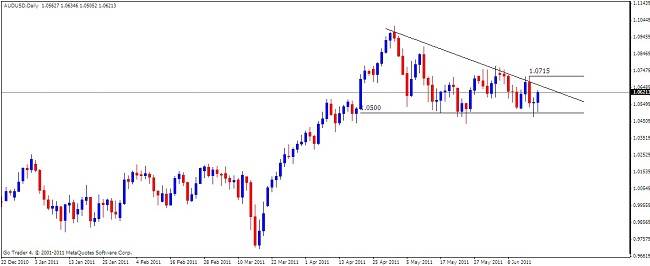
New Zealand Dollar. Our bias BEARISH, we”ll be looking to sell on rallies.
FUNDAMENTALS: The New Zealand Dollar closed the week at 0.8124 against the U.S. Dollar after being buffeted by the recent risk on/risk off market indecision. Economic data from New Zealand is light for the coming week, with all of the scheduled event risk due between Monday and Wednesday. There are two events on the docket, however, that could spark volatility across Kiwi crosses for the coming days, should the broader economic backdrop allow it. At the start of the Asian session on Monday, N.Z. manufacturing data for the first quarter of 2011 is due, and after 3.1% expansion in the fourth quarter of 2010, coupled with the earthquake in February, there may be another consecutive increase amid the rebuilding process and such data would be bullish for the Kiwi. Also on the docket for New Zealand is credit card spending data for May, with credit card data being a strong proxy for consumer spending over a given time period, a key component underpinning the aggregate growth figure. Spending has been particularly strong the past few months, with gains every month dating back to February 2010, apart from July 2010 and March 2011. Spending increased by 6.0% on a year over year basis in April, and the trend could have very well continued in May, as evidenced by climbing food prices, which necessarily suggests consumption has to have increased. Strong data out of New Zealand would be unsurprising, and could lead investors back into the Kiwi, which has been the strongest currency across the board since mid March. However, if the situation in Greece continues to worsen and European officials balk at helping the nearly-insolvent nation, the Kiwi could see further losses as the globe moves further down the path towards an extremely risk averse sentiment.
TECHNICALS: Support at 0.8000, resistance 0.8175. The rally to 0.8300 has the look of exhaustion (the 6th - 9th June range was 1.5 x its 20 day ATR). NZDUSD has also dropped below the support line that extends off of the March and May lows and is looking to re-test that line now as resistance. Resistance also extends to the 61.8% retracement of the decline from the top at 0.8175 with only a daily close above 0.8230 negating the bearish scenario. We remain bearish Kiwi in the week ahead and are looking to sell on rallies.
